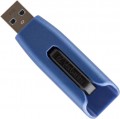Memory size
Total storage capacity. The larger it is, the more information can be simultaneously written to a USB flash drive. For comparison: the size of text documents rarely exceeds 1 MB, audio files and photos usually take several megabytes, short videos — several tens of megabytes, and a DVD-quality movie has a volume ranging from one and a half gigabytes and more. On the other hand, the price of the drive directly depends on this indicator. Thus, many manufacturers have flash drives similar in basic characteristics, differing only in volume — this makes it easier to choose the option that is optimal in terms of price and capacity.
Now on the market there are flash drives with the following volume:
4 GB,
8 GB,
16 GB,
32 GB,
64 GB,
128 GB,
256 GB,
512 GB and more.
USB version
The method of connecting a flash drive to a PC (laptop) provides both a connector (plug type) and an interface (speed). Among these are:
USB 2.0,
USB 3.2 gen1,
USB-C,
microUSB and
Lightning. More details about each of them:
—
USB 2.0. A universal interface used in computer technology to connect a wide variety of devices, including external drives. Version 2.0 provides data transfer rates up to 480 Mbps and is the most common today; almost all models of computers and laptops, and even some tablets, are equipped with such a port (often more than one). Note that the term "USB 2.0" in this case means an interface that uses a classic USB connector; models with a Type-C plug are listed in a separate category (see below).
—
USB 3.2 gen1. An improved version of the USB standard. It provides a 10-fold increase in data transfer speed (up to 4.8 Gbps) compared to the USB 2.0 revision, as well as higher power output, making it easier to connect multiple devices to a single port via a hub. As with USB 2.0 (see above), this category includes devices with the classic full-size USB connector. USB 2.0 and 3.2 Gen1 standards are mutually compatible — meaning that a USB 3.2 Gen1 port can easily connect to a second-generation device and vic
...e versa. The speed will naturally be limited by the slower interface, i.e., USB 2.0. At the same time, manufacturers may label their flash drives as 3.1 (the former name of the current 3.2 Gen2 interface), but the speeds indicate that this is not the second generation, but the first, i.e., 3.0 under the previous name. With the changing interface names, it can become even more confusing, so look directly at the speed indicators, which will more accurately describe the performance of the model.
— USB 3.2 gen2. The next major update to the USB interface after USB 3.2 Gen1 (previously also known as USB 3.1 Gen2 and USB 3.1). The maximum connection speed has doubled compared to the previous version — almost reaching 10 Gbps. As is typical for the standard, this interface uses a USB-A connector and is backward compatible with previous revisions — USB 2.0 and 3.2 Gen1. The only caveat is that the operating speed will be limited by the capabilities of the slower version.
— microUSB. A kind of "mobile" version of the USB standard, used in portable devices like smartphones and tablets. Accordingly, flash drives with such a connection interface are designed specifically for mobile gadgets, or rather, for equipment that supports the USB OTG function (see "Functions / Capabilities"). To connect via USB OTG peripherals with a regular USB plug, you would have to use an adapter, and a microUSB flash drive can be plugged in directly. At the same time, the design of such flash drives can also include a classic full-size plug, which makes them very versatile.
— USB-C. Formally, USB-C is not a separate connection interface, but a type of connector through which a connection can be made using one of the USB versions described above. The connector itself is significantly different from the classic USB connector. Firstly, it has a smaller size and can be used with equal ease in both stationary and portable equipment. Secondly, it is made double-sided, which greatly facilitates the connection: the plug can be inserted the first time even blindly, without worrying which side to turn the flash drive. This plug is not compatible with earlier USB ports, which is why USB-C flash drives are most often used in parallel with a regular full-size plug.
— Lightning. Also known as 8-pin. Apple's proprietary connector used in portable equipment (primarily iPhone and iPad), since 2012. Accordingly, the Lightning connector is equipped with flash drives designed for use with "apple" gadgets. Moreover, this interface, usually, is not the only one — it usually complements the standard USB connector.Read speed
The maximum speed of reading data from the drive. The
higher this speed, the faster you can rewrite information from a flash drive to a computer disk, which is especially important when working with large amounts of data. In fact, the reading speed depends on a number of factors, including the interface bandwidth (see Connection interface), the design features of the drive and computer, the software used, system load, etc.
Write speed
The maximum speed of writing data to the drive. The
higher the write speed, the less time it takes to transfer information from a computer to a USB flash drive, which is especially critical for large amounts of data. Just like the read speed, in fact the write speed is determined by a number of factors, in particular, the connection interface (see Connection interface), the design features of the drive, system load, etc.
Lanyard hole
A hole in the body of the flash drive that allows you to securely fasten the drive to the strap and wear it as a key fob. As a rule, the
eyelet for the strap is located on one of the ends of the flash drive body (on the side or in the center).

